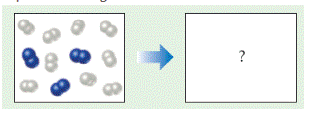
Concept explainers
In the following diagram, the white spheres represent hydrogen atoms and the blue Sphere represent the nitrogen atom.

The two reactants combine to form a single product, ammonia, NH3, which is not shown. Write a balanced chemical equation for the reaction Based on the equation and the contents of the left (reactants) box, how many NH3, molecules should be shown in the right product box?
- 2
- 3
- 4
- 6
- 9
Learn your wayIncludes step-by-step video

Chapter 3 Solutions
Chemistry: The Central Science Plus Mastering Chemistry with Pearson eText -- Access Card Package (14th Edition)
Additional Science Textbook Solutions
Human Anatomy & Physiology (2nd Edition)
Microbiology with Diseases by Body System (5th Edition)
Organic Chemistry (8th Edition)
Anatomy & Physiology (6th Edition)
Campbell Biology: Concepts & Connections (9th Edition)
Biology: Life on Earth with Physiology (11th Edition)
- Given the standard enthalpies of formation for the following substances, determine the reaction enthalpy for the following reaction. 4A (g) + 2B (g) → 2C (g) + 7D (g) AHrxn =?kJ Substance AH in kJ/mol A (g) - 20.42 B (g) + 32.18 C (g) - 72.51 D (g) - 17.87arrow_forwardDetermine ASran for Zn(s) + 2HCl(aq) = ZnCl2(aq) + H2(aq) given the following information: Standard Entropy Values of Various Substance Substance So (J/mol • K) 60.9 Zn(s) HCl(aq) 56.5 130.58 H2(g) Zn2+(aq) -106.5 55.10 CI (aq)arrow_forward3) Catalytic hydrogenation of the compound below produced the expected product. However, a byproduct with molecular formula C10H12O is also formed in small quantities. What is the by product?arrow_forward
- What is the ΔHorxn of the reaction? NaOH(aq) + HCl(aq) → H2O(l) + NaCl(aq) ΔHorxn 1= ________ kJ/molarrow_forward= +92kJ ΔΗ = +170kJ Use the following reactions: 2NH3(9) N2(g) + 3H2(g) → 11/N2(g) + 2H2O (1) → NO2(g) + 2H2(g) Determine the DH° of this reaction: NO2(g) + H2(g) → 2(g) → 2H2O(l) + NH3(9) ΔΗarrow_forwardDetermine the entropy change for the reaction SO2(g) + O2(g) following information: Standard Entropy Values of Various Substance Substance SO2(g) 02(g) SO3(g) So (J/mol K) 248.2 205.0 256.8 → SO3(g) given thearrow_forward
- Indicate which one of the following reactions most certainly results in a negative AS sys. O1402(g) + 3NH4NO3 (s) + C10 H22(1) → 3N2(g) + 17H2O(g) + 10CO2(g) ○ CO2(aq) = CO2(g) ○ H₂O(g) = H₂O(s) CaCO3(g) = CaO(s) + CO2(g) O CuSO4.5H2O(s) = CuSO4(s) + 5H2O(g)arrow_forwardEstimate the DH°rxn of the reaction below: H H-C-C=C-H H Н A table of bond energy Bond H Bond Energy (kJ/mol) C-H 413 C-O 360 C=O 743 C-C 348 |C = C 612 O-H 463 H-H 436 + H-H -> H H-C. - H | | 1 HHHarrow_forwardShow work...don't give Ai generated solutionarrow_forward
- Given the standard enthalpies of formation for the following substances, determine the reaction enthalpy for the following reaction. 3A(g) + 1B (g) 4C (g) + 7D (g) Substance AH in kJ/mol A (g) - 25.07 B (g) - 36.51 C (g) - 90.09 D (g) + 56.11 AHran =?kJarrow_forwardWhat is the change in internal energy (ΔU) when a system is heated with 42.0 J of energy while it does 110.0 J of work?arrow_forwardCan you help me solve this problem and explain what the answers are?arrow_forward
 Chemistry for Engineering StudentsChemistryISBN:9781337398909Author:Lawrence S. Brown, Tom HolmePublisher:Cengage Learning
Chemistry for Engineering StudentsChemistryISBN:9781337398909Author:Lawrence S. Brown, Tom HolmePublisher:Cengage Learning Chemistry for Engineering StudentsChemistryISBN:9781285199023Author:Lawrence S. Brown, Tom HolmePublisher:Cengage Learning
Chemistry for Engineering StudentsChemistryISBN:9781285199023Author:Lawrence S. Brown, Tom HolmePublisher:Cengage Learning Chemistry: The Molecular ScienceChemistryISBN:9781285199047Author:John W. Moore, Conrad L. StanitskiPublisher:Cengage Learning
Chemistry: The Molecular ScienceChemistryISBN:9781285199047Author:John W. Moore, Conrad L. StanitskiPublisher:Cengage Learning ChemistryChemistryISBN:9781305957404Author:Steven S. Zumdahl, Susan A. Zumdahl, Donald J. DeCostePublisher:Cengage Learning
ChemistryChemistryISBN:9781305957404Author:Steven S. Zumdahl, Susan A. Zumdahl, Donald J. DeCostePublisher:Cengage Learning Chemistry & Chemical ReactivityChemistryISBN:9781133949640Author:John C. Kotz, Paul M. Treichel, John Townsend, David TreichelPublisher:Cengage Learning
Chemistry & Chemical ReactivityChemistryISBN:9781133949640Author:John C. Kotz, Paul M. Treichel, John Townsend, David TreichelPublisher:Cengage Learning Chemistry: An Atoms First ApproachChemistryISBN:9781305079243Author:Steven S. Zumdahl, Susan A. ZumdahlPublisher:Cengage Learning
Chemistry: An Atoms First ApproachChemistryISBN:9781305079243Author:Steven S. Zumdahl, Susan A. ZumdahlPublisher:Cengage Learning





